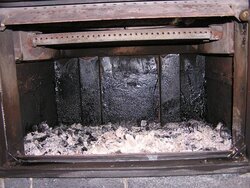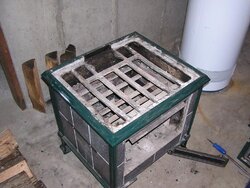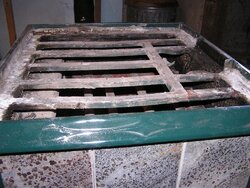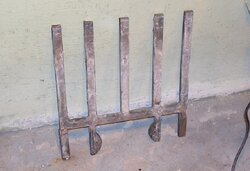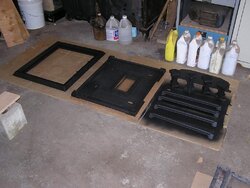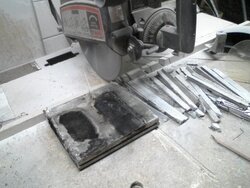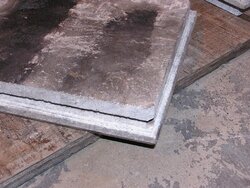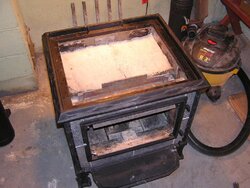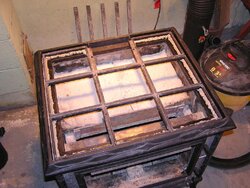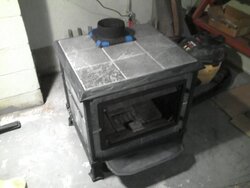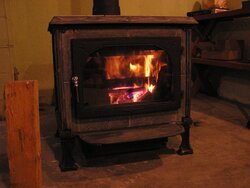Mansfield creosote + complete rebuild
- Thread starter JonOfSunderland
- Start date
-
Active since 1995, Hearth.com is THE place on the internet for free information and advice about wood stoves, pellet stoves and other energy saving equipment.
We strive to provide opinions, articles, discussions and history related to Hearth Products and in a more general sense, energy issues.
We promote the EFFICIENT, RESPONSIBLE, CLEAN and SAFE use of all fuels, whether renewable or fossil.
You are using an out of date browser. It may not display this or other websites correctly.
You should upgrade or use an alternative browser.
You should upgrade or use an alternative browser.
- Status
- Not open for further replies.
I haven't pulled the pipe apart to check, but everywhere else looks normal. Glass is clean, above the baffle is clean, wood is bone dry (2+ years split and stacked, no sizzle at all). This picture was even taken after a small hot fire that I just let run out at full throttle. Flue temps are 600-1000 (probe). Stove top temps are 500-600 (Condar thermometer, not Rutland).
Highbeam
Minister of Fire
Soapstone heats up much more slowly than the iron products and the max temps stay low. We have no firebrick in stone stoves to heat up and prevent this creo accumulation. I believe that such accumulation is normal on stone stoves. I know that my firebox is black on the bare stones, maybe not as shiny but definitely not the same thing you see inside a steel stove with firebricks.
ckdeuce
Feeling the Heat
I have a Mansfiled as well. I do have some shiny Creo on the back wall only, but not to the level you do. Not saying your doing anything wrong, just wanted you to know that another owner has similar symptoms...
agartner
Feeling the Heat
JonOfSunderland said:Does anyone with a Mansfield, or any large firebox stove, notice a decent buildup of shiny creosote on the back wall of the firebox?
Whoa! I've been considering putting a Hearthstone Heritage on my main living level come spring (2nd woodstove). Do the soapstone stoves really tend to blacken up like this? I would think once it got up to "running temp" it would simply burn off. The firebrick in my steel box stove is all tan, they never get any buildup like that.
-Al.
Kent Sherwood
lazeedan
Feeling the Heat
my mansfield has that also, mabe not as glossy, but my woodstock fireview has a light grey looking firebox. I see you rebuilt your mansfield. I just got done doing the same thing , mine was overfired and needed some fab work on the top cast due to cast warpage. Ive seen a couple of posts on here about overfired mansfields. what was wrong with yours?
Todd
Minister of Fire
Seems excessive to me. I don't know how creosote can form in a fire box, especially in a non cat where the internal temps are easily over 1000 degrees. My stove never looked like that, neither did my Homestead or numerous other stoves.
sauer said:my mansfield has that also, mabe not as glossy, but my woodstock fireview has a light grey looking firebox. I see you rebuilt your mansfield. I just got done doing the same thing , mine was overfired and needed some fab work on the top cast due to cast warpage. Ive seen a couple of posts on here about overfired mansfields. what was wrong with yours?
I posted a while back about how the top had warped and previous owners had removed the top stones and shimmed them back up level with washers, pieces of sheet metal, and nickels and pennies. I cut out the warped sagging rails from the top casting and put in a new style stone support grid and cut the stones to fit. I also had all the iron sandblasted (I hated the moss green enamel) and painted everything black. Next I'm going to try making new baffle plates out of castable refractory. The original plates are badly warped and the blanket is pretty deteriorated. We'll see how that works.
It just so happens my wife and I just bought a house and the stove would've needed to be transferred from one basement to another. I highly recommend moving a Hearthstone in pieces if you can. I started the process this summer and just got it fired up for the first time last weekend. It's plumbed into an 8x12 interior masonry chimney with Selkirk DSP pipe.
Here's some pics...
Attachments
As for the creosote, I'm gonna see if (1) the secondary air risers aren't sealing well in the back/bottom of the stove, or (2) perhaps the badly warped baffles and resulting stray exhaust paths are causing problems.
ckdeuce
Feeling the Heat
JonOfSunderland said:As for the creosote, I'm gonna see if (1) the secondary air risers aren't sealing well in the back/bottom of the stove, or (2) perhaps the badly warped baffles and resulting stray exhaust paths are causing problems.
I find that it is worse when I load east/west to get a longer burn. Again, I would not worry as long as your chimney is clean. NICE job on the rebuild!! Looks great!
yanksforever
Member
I have the Mansfield and I have no shiny on the back of the stove what so ever. Are you burning hot and full? How long
is the chimney height? Do you run with a damper? Do you cover the top of your wood when seasoning for 2 full years?
Do you get consistant secondary burns? You also mentioned a full rebuild block by block. Was everything done to spec by a knowledgeable stove expert? Let us know all the answers and we will look for a problem for you.
is the chimney height? Do you run with a damper? Do you cover the top of your wood when seasoning for 2 full years?
Do you get consistant secondary burns? You also mentioned a full rebuild block by block. Was everything done to spec by a knowledgeable stove expert? Let us know all the answers and we will look for a problem for you.
Backwoods Savage
Minister of Fire
Highbeam said:Soapstone heats up much more slowly than the iron products and the max temps stay low. We have no firebrick in stone stoves to heat up and prevent this creo accumulation. I believe that such accumulation is normal on stone stoves. I know that my firebox is black on the bare stones, maybe not as shiny but definitely not the same thing you see inside a steel stove with firebricks.
Whoa


It does take a bit to heat up the stone. We take our stove top to 700 degrees but Hearthstone recommends only 600 degrees. But, an accumulation like is shown in the pictures is NOT normal.
The only time we had any black in our stove was on the initial burn in. Since then there is no black and you can look inside the firebox and find no black. It is not normal at all.
Backwoods Savage
Minister of Fire
agartner said:JonOfSunderland said:Does anyone with a Mansfield, or any large firebox stove, notice a decent buildup of shiny creosote on the back wall of the firebox?
Whoa! I've been considering putting a Hearthstone Heritage on my main living level come spring (2nd woodstove). Do the soapstone stoves really tend to blacken up like this? I would think once it got up to "running temp" it would simply burn off. The firebrick in my steel box stove is all tan, they never get any buildup like that.
-Al.
Kent Sherwood
Kent, it does appear there can be a problem with the Hearthstone but I've not seen that so far with any Woodstock soapstone. See my above post.
Fsappo
Minister of Fire
I just checked the Mansfield in our showroom. A very small amount of the shiny stuff. That stove was burned all winter on mostly full loads with the air closed down all the way most days.
Highbeam
Minister of Fire
Old thread here Dennis. Try to realize that this is a hearthstone.
It's still normal, just look at the responses. Mine does it now especially with shoulder season burning. Lots of hot fires and hot flue temps but the stove temps on the top only get up to 500 occasionally. Again, there is no firebrick or double wall stone construction on the hearthstones so they are cold until a long and hot burn near redline. The air in the firebox is of course much hotter.
It's like an ice cold can of coke. It will sweat and condense on that stone during the first part of the burn and then won't burn off unless you really try hard.
It's still normal, just look at the responses. Mine does it now especially with shoulder season burning. Lots of hot fires and hot flue temps but the stove temps on the top only get up to 500 occasionally. Again, there is no firebrick or double wall stone construction on the hearthstones so they are cold until a long and hot burn near redline. The air in the firebox is of course much hotter.
It's like an ice cold can of coke. It will sweat and condense on that stone during the first part of the burn and then won't burn off unless you really try hard.
BrowningBAR
Minister of Fire
Backwoods Savage said:Highbeam said:Soapstone heats up much more slowly than the iron products and the max temps stay low. We have no firebrick in stone stoves to heat up and prevent this creo accumulation. I believe that such accumulation is normal on stone stoves. I know that my firebox is black on the bare stones, maybe not as shiny but definitely not the same thing you see inside a steel stove with firebricks.
Whoa
It does take a bit to heat up the stone. We take our stove top to 700 degrees but Hearthstone recommends only 600 degrees. But, an accumulation like is shown in the pictures is NOT normal.
The only time we had any black in our stove was on the initial burn in. Since then there is no black and you can look inside the firebox and find no black. It is not normal at all.
I know two Hearthstone Heritage stove owners and a neighbor with an older non-cat fireview. None of the stoves produce anything at all like the photos shown. The Heritage I picked up doesn't look like that, either.
Rob From Wisconsin
Minister of Fire
This doesn't appear to be a problem to me.
From what I can see from the 1st picture, the burn tubes
appear to be fairly scortched, which means secondary combustion is
happening through much of the burn cycle.
Do you pack your stove full for a prolonged burn?
If that is the case, there is quite a distance from front to back
on your model, and the rear of the firebox is bound to be cooler,
but the smoke will eventually be heated to combustion temp as
it travels to the front & exits to the flue.
From what I can see from the 1st picture, the burn tubes
appear to be fairly scortched, which means secondary combustion is
happening through much of the burn cycle.
Do you pack your stove full for a prolonged burn?
If that is the case, there is quite a distance from front to back
on your model, and the rear of the firebox is bound to be cooler,
but the smoke will eventually be heated to combustion temp as
it travels to the front & exits to the flue.
yanksforever
Member
Its not a Hearthstone or a Mansfield problem. I have NO shiny creasote what so ever. Could be a problem with the wood or the rebuild.
NH_Wood
Minister of Fire
My Mansifield has some shiny creosote on the back and sides, but I've only had the stove since early March. I've had a lot of cold starts with ~ 8 month seasoned (i.e. marginal) wood - getting dirty glass quite easily, etc. I'm guessing the black in the stove is due to the suboptimal wood. That said, the wood is good enough that it takes off easily on a bed of coals and I get excellent stove/stack temps, good secondaries, good burn times, etc. My question is: with high internal stove temps, why wouldn't this material burn off? I thought that the recommendation (by Hearthstone) to burn hot for ~ 30 min per day was to clean the creosote building up in the stovepipe - if so, shouldn't this also burn off the creosote INSIDE the stove? Cheers!
Wow didn't expect this thread to catch on again. Here's some updates...
(1) The baffle plates were extremely warped and the insulating blanket was disintegrating. So I made a new set of baffle plates using castable refractory. They overlap each other and seal down the middle better than the steel plates did, preventing the gases from escaping straight up. And since they reflect heat much better they eliminated the need for the blanket.
(2) My wood was not as dry as it should have been as I was moving down the pile, so that definitely contributed to the creosote. I switched from stuffing the firebox full to building shorter/hotter fires and that took care of the issue.
I'm actually thinking about selling the stove and picking up a PE Summit, just to try something different. Plus the stove is in the basement which isn't really a living area. Kind of a waste of a pretty soapstone stove.
(1) The baffle plates were extremely warped and the insulating blanket was disintegrating. So I made a new set of baffle plates using castable refractory. They overlap each other and seal down the middle better than the steel plates did, preventing the gases from escaping straight up. And since they reflect heat much better they eliminated the need for the blanket.
(2) My wood was not as dry as it should have been as I was moving down the pile, so that definitely contributed to the creosote. I switched from stuffing the firebox full to building shorter/hotter fires and that took care of the issue.
I'm actually thinking about selling the stove and picking up a PE Summit, just to try something different. Plus the stove is in the basement which isn't really a living area. Kind of a waste of a pretty soapstone stove.
- Status
- Not open for further replies.
Similar threads
- Replies
- 23
- Views
- 981
- Replies
- 14
- Views
- 397
- Replies
- 32
- Views
- 2K
- Replies
- 2
- Views
- 1K


